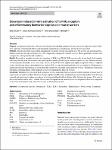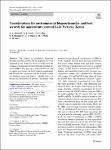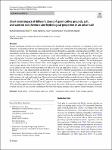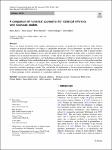Search
Author
- Osman, Ahmed I. (5)
- Chen, Zhonghao (2)
- Ricohermoso III, Emmanuel (2)
- Wang, Yongbin (2)
- next >
Subject
- LCA (6)
- ICP-MS (3)
- Artificial intelligence (2)
- CDW (2)
- next >
Date issued
Has File(s)
- true (220)
Search Results
Occupational exposure to bioaerosols during waste handling remains a health concern for exposed workers. However, exposure-related health effects and underlying immunological mechanisms are still poorly described. |
International water conventions—e.g., the 1997 United Nations Convention on the Non-Navigational Uses of International Watercourses—include positive but insufficient focus on groundwater and its interaction with surface water. As such, a growing body of literature has proposed modifications to existing frameworks to enable consideration to surface and groundwater and their interactions. While this literature places considerable focus on coupling and amending existing legal frameworks, elaboration and evaluation of a new protocol on conjunctive water management comprises a key gap. To fill this gap, this paper seeks to answer the following question: does formulation and adoption of a new “conjunctive” protocol provide more value than existing proposals centered around modifications t... |
Seasonal movements between the summer and winter areas are a widespread phenomenon in bats So far, most information on the migration ecology of bats has been obtained by studies in terrestrial habitats, whereas scientific knowledge on migration over sea is scarce. We performed continuous ultrasonic acoustic monitoring at 13 locations in the southern North Sea during four consecutive years (2017–2020) and analysed the spatiotemporal occurrence of Nathusius’ pipistrelle Pipistrellus nathusii during autumn migration in relation to weather parameters and lunar phase. Our analysis showed that the main autumn migration of Nathusius’ pipistrelle at the southern North Sea occurs from mid-August until late October and most bats within the study area occur off the Noord Holland coast. |
We investigated the extent to which ward-level leadership quality was associated with prospective low-back pain among eldercare workers, and how this association was mediated by observed resident handlings. |
Untreated landfill leachate can harm the environment and human health due to its organic debris, heavy metals, and nitrogen molecules like ammonia. Microbial fuel cells (MFCs) have emerged as a promising technology for treating landfill leachate and generating energy. However, high concentrations of total ammonia–nitrogen (TAN), which includes both ammonia and the ammonium ion, can impede MFC performance. Therefore, maintaining an adequate TAN concentration is crucial, as both excess and insufficient levels can reduce power generation. To evaluate the worldwide research on MFCs using landfill leachate as a substrate, bibliometric analysis was conducted to assess publication output, author-country co-authorship, and author keyword co-occurrence. |
The impact of population expansion through economic growth and development has been identified as one of the key drivers of both water and sediment contamination from potentially harmful elements (PHEs). This presents a major hazard not only to aquatic ecosystems but local riparian communities and beyond who rely heavily on this natural resource for drinking water and fish—a valuable source of dietary micronutrients and protein. The present study measured biogeochemical concentration of PHEs in water, sediment and fish from locations pooled into four zones within Winam Gulf and Lake Victoria area of Kenya. |
Recycling of e-waste (waste electrical and electronic equipment) represents an important abatement of pressure on the environment, but recycling rates are still low. This study builds on common environmental economics approaches to identify the main driving forces of the e-waste recycling rate. The environmental Kuznets curve hypothesis was applied in the context of the STIRPAT (stochastic impacts by regression on population, affluence and technology) model to analyze data from 30 European countries over the period 2008–2018. Panel quantile regression was conducted to determine the relationship between e-waste recycling rate and economic growth, population, population density, energy intensity, energy efficiency, credit to private sector and e-waste collected. |
The risks associated with the use of peloids in thermal centers, spas, or at home, must be tested to develop appropriate safety guidelines for peloids formulations and the release of substances of high concern. Additionally, the beneficial effects of some elements on human health should be assessed to aid in interpreting the therapeutic action and effectiveness of pelotherapy on dermatological or osteomuscular disorders. Therefore, a methodology was developed to better understand the biogeochemical behavior of the elements in formulated peloids. Two peloids were formulated with the same clay and two different sulfurous mineral-medicinal waters for 90 days, with light stirring every 15 days. |
Natural and human activities have deteriorated urban soil’s health and ecological functions as compared to forest soils. Therefore, we hypothesized that any intervention in poor quality soil in urban area will change their chemical and water retention properties. The experiment was conducted in Krakow (Poland) in completely randomized design (CRD). The soil amendments used in this experiment consisted of control, spent coffee grounds (SCGs), salt, and sand (1 and 2 t ha−1) in order to evaluate the impact of these soil amendments on the urban soil chemical and hydrological properties. Soil samples were collected after 3 months of soil application. The soil pH, soil acidity (me/100 g), electrical conductivity (mS/cm), total carbon (%), CO2 emission (g m−2 day−1), and total nitrogen (%... |
Due to our limited knowledge about complex environmental systems, our predictions of their behavior under different scenarios or decision alternatives are subject to considerable uncertainty. As this uncertainty can often be relevant for societal decisions, the consideration, quantification and communication of it is very important. Due to internal stochasticity, often poorly known influence factors, and only partly known mechanisms, in many cases, a stochastic model is needed to get an adequate description of uncertainty. As this implies the need to infer constant parameters, as well as the time-course of stochastic model states, a very high-dimensional inference problem for model calibration has to be solved. |










